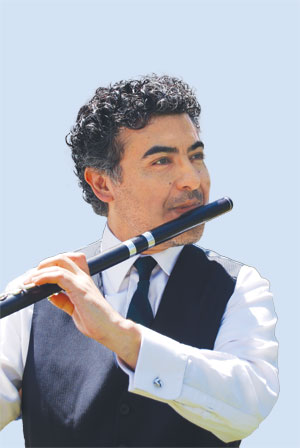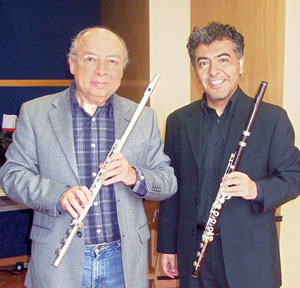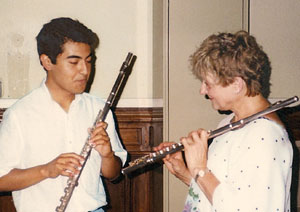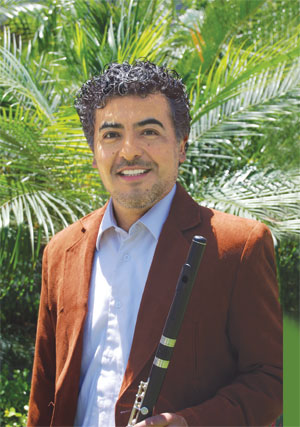 One of the premiere classical flutists of Mexico, nearly all of Miguel Angel Villanueva’s recordings feature the works of Mexican composers. This year he performed a Headliner Recital of these works at the N.F.A. convention. His performance had elegant flair and finesse as he presented sonatas by Samuel Zyman and Eduardo Angulo, Aproximaciones al son huasteco by Horacio Uribe, and Danza de las Bailarinas de Degas by Mario Lavisto.
One of the premiere classical flutists of Mexico, nearly all of Miguel Angel Villanueva’s recordings feature the works of Mexican composers. This year he performed a Headliner Recital of these works at the N.F.A. convention. His performance had elegant flair and finesse as he presented sonatas by Samuel Zyman and Eduardo Angulo, Aproximaciones al son huasteco by Horacio Uribe, and Danza de las Bailarinas de Degas by Mario Lavisto.
Villanueva grew up in Mexico City in a family filled with music. “When I was a kid there was always music at home. I am the sixth of seven brothers, and my siblings all liked various kinds of music – contemporary, big band, Mexican folk, etc., so some kind of music was playing most of the time. Although my brothers and sisters all played musical instruments while growing up, only two of us became professional musicians.”
His brother Fernando, the other professional musician in the family, is a classical guitarist. He and Miguel have recently completed a recording of Giuliani and Carulli flute and guitar works that will be available in the near future.
Despite his early exposure to music, Miguel did not start flute until age 16. He studied piano a little in school, but that was the extent of his musical education until he found the flute. “Actually, as teenager I didn’t really want to study music. I just wanted to be with my friends, in the street, playing football and games. My mother made me go to the music school because she was concerned for me and wanted to get me off the streets. She even bought a piano to try to entice me to play. My other brothers were playing instruments, and she thought it would help me focus if I played a musical instrument too. No one in the family played piano at that time.
“When I was 16 and in the process of applying to the National University (UNAM), my brother brought home a recording of the Bach sonatas played by Gildardo Mojica, one of the greatest Mexican flute players of all times. Rampal had been friends with Mojica and said that he was a great, great flutist.
“When I heard that recording I thought, ‘I want to play that music,’ but my mother continued to insist that I play the piano. Without telling my mother, my brother bought me a very cheap flute, and I went to the school and decided to play the flute there in the National School of Music (part of the National University). When the results came that I had been admitted to the school on flute, she was very angry with me. After all, she had just spent a lot of money on a piano, but in the end she was happy because I was going to study music.”
When asked how he had learned to play so quickly, he explained that he had met an excellent pianist named Rafael Guerra. “He asked me to play with him. I wanted to be as good a flutist as he was a pianist in order to play all that wonderful music. So I started to practice and practice; I played a lot every day. When I was 18, I played my first tour. It went so well that I decided to become a professional musician. Actually, I wanted to be either a musician or a journalist. I wasn’t sure which, but the tour made the decision for me.”
 Miguel attended the National University for three years. “My teacher, Héctor Jaramillo, was then and still is principal in the University Philharmonic Orchestra (OFUNAM). He had just returned from Europe, where he had studied with Karlheinz Zöller from the Berliner Philharmoniker. I think that I was fortunate to have him as a teacher because he worked a lot on sound with me. He and Zöller were obviously my models.”
Miguel attended the National University for three years. “My teacher, Héctor Jaramillo, was then and still is principal in the University Philharmonic Orchestra (OFUNAM). He had just returned from Europe, where he had studied with Karlheinz Zöller from the Berliner Philharmoniker. I think that I was fortunate to have him as a teacher because he worked a lot on sound with me. He and Zöller were obviously my models.”
Europe
In 1984 Miguel entered the Ecole Normale de Musique de Paris and the Conservatoire National de Region de Saint-Maur in Paris, where he was awarded a Diplome Superieur d’Execution and Médaille d’Or respectively. “I was 19 when I went to France. I worked with four flute teachers while I was there. The first one was Jacques Royer from the Orchestre de Paris. Then I studied with Rampal’s assistant, Ida Ribera, and then Shigenori Kudo. My last teacher, Michel Moragues, was particularly excellent in terms of pedagogy; he plays in the Orchestre National de France.
“At that time Michel Debost was still at the Conservatory but I studied at a different school – The National Superior Conservatoire. Because of my age, I could not get into the Paris Conserv-atory; I was considered too old. So I went to the next level of conservatories.
“That is when I met Rampal. Flute study was very difficult there, because I was not really good enough to be there, although I thought I was. In my school in Mexico City I was the best flutist, but I was shocked when I went to Paris and heard the flute players there.
 “I was in the flute class of Rampal’s assistant, Madame Ribera, with a little girl. We arrived and Madame Ribera motioned us into the room and asked us to sit down. This little girl quietly picked up her flute and got ready to play. Then, all of a sudden, she proceeded to play the first movement of the Ibert Concerto by memory. She was so amazing. I didn’t want to play after that. Ribera taught me correct playing posture. She said, “You Latinos like to play, but you don’t like to work.” I thought, ‘Ah – she is right. I want to play, I like to play, but I don’t know how to work on sound or scales or arpeggios. So she taught me to do all those things. It took me about three years to acquire a really good basic foundation.
“I was in the flute class of Rampal’s assistant, Madame Ribera, with a little girl. We arrived and Madame Ribera motioned us into the room and asked us to sit down. This little girl quietly picked up her flute and got ready to play. Then, all of a sudden, she proceeded to play the first movement of the Ibert Concerto by memory. She was so amazing. I didn’t want to play after that. Ribera taught me correct playing posture. She said, “You Latinos like to play, but you don’t like to work.” I thought, ‘Ah – she is right. I want to play, I like to play, but I don’t know how to work on sound or scales or arpeggios. So she taught me to do all those things. It took me about three years to acquire a really good basic foundation.
“I didn’t find her comment offensive because it was evident. That little girl, and all of Ribera’s students, were so solid in their technical foundation. I could see that. That’s one of my strong assets. I was so sensitive that I could perceive that I was not at the same level as the rest of the players in that class. Something was missing in my approach to the flute. That’s why I became very humble about the work. My response was ‘Let’s get the work done.’ What I needed was working structure, and she gave that to me.” Villanueva’s attitude and hard work paid off with a subsequent first prize at both the Nerini and Bellan Competitions in Paris and a third prize at the UFAM International Competition.
In 1992 Miguel returned to Mexico hoping to find an orchestra job, but all the positions were full, and there were no prospects for future openings. His sister was working at the Mexican consulate in Germany and invited Miguel to join her in Berlin. “I spent two years there. I wasn’t eager to enter another school. I had been in school long enough, but I visited lots of flute classes and saw Emmanuel Pahud for the first time. I attended Berlin Philharmonic concerts every week. Just listening to them was like a special masterclass. I played with a couple of orchestras there, and even played a solo with one once. For me the entire experience was like learning music. Paris had been about the flute, and Berlin was about the music. German orchestras have a different concept of music. When you listen to a French orchestra you hear an orchestra of soloists, but in Germany the orchestra sounds like one instrument. It is a very different concept. It was very good for me.
“After two years in Berlin I again returned to Mexico, and this time there was a job opening available. I was invited to play principal in the Fine Arts Chamber Orchestra, and the teaching position at the National University was also open. There was a competition for the teaching position and I won the job.
“However, most of the flute students at the university were from the U.S., and the flute playing style in U.S. was different from the style I had developed in Europe. At that time, even conductors sometimes asked me to play more in what they called the U.S. style of flute playing. It was very difficult because they thought that I sounded like a soloist, not like an orchestral flutist. These comments eventually guided me to a soloist’s career because I could not play in an orchestra the way conductors and woodwind section musicians were requesting. They would say, “It sounds great, but it sounds too French. In France, they had said I played too Mexican.
“I think the differences they were hearing related to vibrato and articulation. In my opinion, the French School of flute playing is more refined. Articulation also relates to language. I tried the French ‘e’(oeh) and found it more elegant. It is a vowel sound that not only rounds the lips but also optimizes the air stream flow. In Mexico flutists of the past had played very tight and smiley, but the new French School teaches playing with relaxed lips. It took me many years, but I learned to relax the lips more.”
 When asked if his varied learning experiences have made him a better teacher today, he responded, “Yes, because it was very difficult to make the initial changes that I made in the technical aspects of flute playing. It was also emotionally difficult to retrain as a beginner at the age of 19. All of a sudden I was a debutante – a beginner – old by French standards. Learning from the beginning at the age of 19 was very difficult….Now, students in their 20s sometimes arrive at the University as beginners. They think perhaps they are too old, but I tell them that age is not important. When I see very good musicians playing, I don’t care about their age. They should just focus on learning the correct way to play. Then age is not an important matter.”
When asked if his varied learning experiences have made him a better teacher today, he responded, “Yes, because it was very difficult to make the initial changes that I made in the technical aspects of flute playing. It was also emotionally difficult to retrain as a beginner at the age of 19. All of a sudden I was a debutante – a beginner – old by French standards. Learning from the beginning at the age of 19 was very difficult….Now, students in their 20s sometimes arrive at the University as beginners. They think perhaps they are too old, but I tell them that age is not important. When I see very good musicians playing, I don’t care about their age. They should just focus on learning the correct way to play. Then age is not an important matter.”
Miguel currently teaches about 15 students at the university, from children in the school’s preparatory division through master’s degree students. The preparatory division is a three-year program, and the professional four-year degree program is for college students. Similar to U.S. higher education formats, graduate school follows the four-year undergraduate program. He teaches students from all these levels on top of his solo career and a family. He states proudly, “My wife Luisa and I have 4-year old twins. They are very musical and like to go to my concerts. They love to listen to my CDs.”
The Composers
Villanueva’s recordings are almost all dedicated to the works of Mexican composers. “Since returning to my country I have worked a lot with Mexican composers – commissioning them to write works for flute and other instruments. So far I have commissioned about 20 flute concertos by most of the best Mexican composers, as well as chamber music pieces for flute in various instrumental combinations.
“I believe that one of the reasons that musicians outside of Mexico know little about our composers and music is that Mexico does not have artists’ managers to represent Mexican musicians. Mexican musicians have to perform those management duties by themselves. So every day I have to decide between practicing my flute or doing public relations. To keep both activities in balance is difficult.” In fact, that decision will be easier in the future because he obtained American representation this fall and is now represented by Price Rubin & Partners. “For the first time I have a manager,” he sighed.
When asked what he would like to be doing 15 years from now, he replied without hesitation, “Continuing to enjoy what I do. That is the most important thing. I would also like to make Mexican composers known worldwide. When you listen to the music on my recordings you will hear that there are a lot of really fine Mexican composers writing excellent flute works. Eduardo Agulo’s musical language, for example, is traditional, but his orchestration is very well done. There is a lot of very high-level music on my recordings.” His CDs include the entire works for flute by Mexican composer Eduardo Angulo and flute concertos by Eugenio Toussaint, Horacio Uribe, Lucía Álvarez and many others.
“We are neighbors [the U.S. and Mexico], yet we don’t know each other as well as we should. Mexican composers are very good. When I play Mexican music, I share one of the best parts of my country – wonderful things that you probably won’t find in the news, on TV, or in the newspapers. In an interview for a Mexican newspaper last week, the reporter asked why I was bringing music to the U.S. when the problems with immigration were so rampant. I answered that we have to know each other better. Music is universal, and I want everyone to know one of Mexico’s best faces: its art.”






